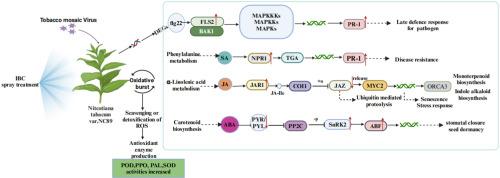异巴伐醌诱导烟草抵抗烟草花叶病毒病的作用机制
IF 2.8
3区 农林科学
Q2 PLANT SCIENCES
引用次数: 0
摘要
异巴夏尔酮(IBC)是一种天然活性化合物,提取自 Psoralea corylifolia L. 的种子,是一种植物杀真菌剂,已被证明能有效控制农业环境中由病原真菌、细菌和病毒引起的各种植物病害。然而,IBC诱导烟草抵抗烟草花叶病毒(TMV)感染的机制仍不清楚。在本研究中,烟草植株处于 6~8 叶期,在接种 TMV 前用 40 mg/L IBC 处理三次。接种后 24 h,IBC 处理组与接种对照组的差异表达基因主要富集于植物激素信号转导和 MAPK(丝裂原活化蛋白激酶)信号通路。在上述信号通路中,正调控因子 JAR1、SnRK2、ABF、FLS2 和 PR 的表达水平显著上调,而负调控因子 JAZ 的表达水平显著下调。从接种后 1 到 9 天,IBC 处理的烟草叶片中 SOD、PPO、PAL 和 POD 四种防御酶的活性明显高于接种对照。这些结果表明,IBC能激活植物体内的MAPK信号通路,调节SA、JA和ABA等植物激素信号网络在免疫反应中的协调作用,提高烟草体内致病相关蛋白和防御酶的活性,从而诱导烟草对TMV的抗性。本研究从转录组学和生理生化水平揭示了 IBC 诱导烟草抗 TMV 的机理,为 IBC 在农业上的广泛应用提供了理论依据。本文章由计算机程序翻译,如有差异,请以英文原文为准。

Mechanism of action of isobavachalcone in inducing resistance to tobacco mosaic virus disease in tobacco
Isobavachalcone (IBC), a natural active compound derived from the seeds of Psoralea corylifolia L., is a botanical fungicide that has been shown to effectively manage various plant diseases caused by pathogenic fungi, bacteria, and viruses in agricultural settings. However, the mechanism by which IBC induces tobacco resistance to tobacco mosaic virus (TMV) infection remains unclear. In this study, tobacco plants at the 6~8 leaf stage were treated with 40 mg/L IBC three times before inoculation with TMV. At 24 h post-inoculation, differentially expressed genes between the IBC-treated group and the inoculated control group were mainly enriched in plant hormone signal transduction and MAPK(mitogen-activated protein kinase)signaling pathways. The expression levels of positive regulatory factors JAR1, SnRK2, ABF, FLS2, and PR in the above signaling pathways were significantly up-regulated, while the expression level of the negative regulatory factor JAZ was significantly down-regulated. From 1 to 9 days post-inoculation, the activities of four defense enzymes, SOD, PPO, PAL, and POD, in the IBC-treated tobacco leaves were significantly higher than those in the inoculated control. These results suggest that IBC activates the MAPK signaling pathway in plants, regulates the coordination of SA, JA, and ABA plant hormone signaling networks in immune responses, and increases the activities of pathogenesis-related proteins and defense enzymes in tobacco to induce resistance against TMV. This study reveals the mechanism of IBC-induced resistance against TMV in tobacco at the transcriptomic and physiological-biochemical levels, providing a theoretical basis for the widespread application of IBC in agriculture.
求助全文
通过发布文献求助,成功后即可免费获取论文全文。
去求助
来源期刊
CiteScore
4.30
自引率
7.40%
发文量
130
审稿时长
38 days
期刊介绍:
Physiological and Molecular Plant Pathology provides an International forum for original research papers, reviews, and commentaries on all aspects of the molecular biology, biochemistry, physiology, histology and cytology, genetics and evolution of plant-microbe interactions.
Papers on all kinds of infective pathogen, including viruses, prokaryotes, fungi, and nematodes, as well as mutualistic organisms such as Rhizobium and mycorrhyzal fungi, are acceptable as long as they have a bearing on the interaction between pathogen and plant.

 求助内容:
求助内容: 应助结果提醒方式:
应助结果提醒方式:


